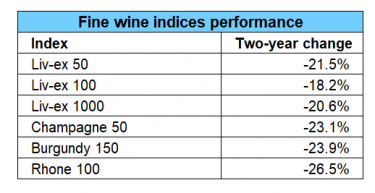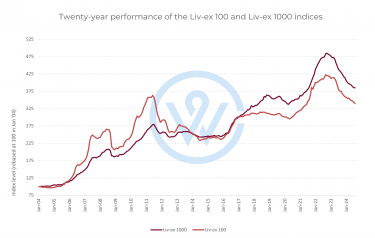What is a market dip, and how can fine wine investors take advantage?
- A market dip is a temporary decline in prices, caused by economic or market-specific factors.
- Buying the dip is advised when the underlying market fundamentals are favourable.
- This is arguably the best time to invest in fine wine in a decade.
A market dip is a temporary drop in prices. This is often caused by economic or market-specific factors. In the fine wine market, these dips are less frequent and less volatile compared to traditional financial markets like stocks or bonds. While the fine wine market has been bearish three times since the turn of the century, global mainstream markets have experienced many more significant crashes.
However, when a dip does occur, and provided that the fundamentals are strong, it can present a unique opportunity for buyers. Investors can enter the market, adjust their allocations or expand their portfolios with high-value brands and rare vintages at discounted prices. Sellers may look to liquidate their stock, offering rare and premium wines from regions like Bordeaux, Burgundy, and Champagne at more attractive prices.
Currently, the fine wine market is benefitting buyers. While the temporary drop in prices might raise concerns on the surface, those who adopt a long-term, strategic approach can reap significant rewards by buying the dip.
Buying the dip when the fundamentals are strong
According to Sir John Templeton, the best time to invest is during ‘points of maximum pessimism’. With fine wine indices down over 20% from their 2022 peaks, this moment presents one of the best opportunities to buy in the last decade.
Fine wine fundamentals remain intact: wines improve with age, and become rarer over time as bottles are consumed. The market’s appetite for older vintages is still strong, and regions like Burgundy, Bordeaux and Champagne continue to break pricing records at auction.

Current macroeconomic environment and its impact
The global economy is currently facing several challenges – rising inflation, high interest rates, and geopolitical tensions, all of which have contributed to the recent dip in fine wine prices.
Despite these macroeconomic factors, fine wine remains less volatile than traditional markets. During times of economic uncertainty, fine wine’s tangible nature and intrinsic value have helped it weather storms better than more speculative assets like equities or cryptocurrencies.
Additionally, the growing demand for luxury goods continues to support the fine wine market. This demand will likely drive the next phase of growth once global economic conditions stabilise.
Historical fine wine market rebounds
Another reason for confidence is that the fine wine market has consistently rebounded after periods of economic downturn. During the 2008 global financial crisis, the Liv-ex 100 index fell by 25% but had risen over 60% by mid-2011.

Similarly, Bordeaux’s peak in 2011 was followed by Burgundy’s rise, showing that demand for fine wine remains strong even if it shifts on a regional basis. This is why diversity is key.
The market is no longer dominated solely by top Bordeaux, and spreading your allocations across key wines and vintages can balance an investment portfolio and maximise returns.
How to take advantage of the dip in the fine wine market
For investors looking to capitalise on the current market dip, the strategy is clear: buy low and hold for the long term.
Focus on proven performers: Wines from top regions like Bordeaux, Burgundy, Italy and Champagne have historically demonstrated resilience. Investing in top vintages and estates offers a measure of security.
Take advantage of fear-driven selling: As some sellers look to exit the market prematurely, investors can acquire undervalued wines with strong growth potential.
Diversify your portfolio: Spread your investment across different regions, producers, and vintages to mitigate risk and maximise returns.
Get in touch to discuss your allocations or to start building your fine wine collection. Schedule a consultation.
Three reasons why the Brexit deal will prevent customers from paying more for their wine.
Ever since the UK voted to leave the European Union in 2016, trade talks and negotiations between the two sides had been full of uncertainty, posturing and brinkmanship which at times made it feel like a deal was unobtainable. So, the news that a trade deal – now ratified by the UK Parliament - had been struck on Christmas Eve last year was met with welcome relief across all industry sectors on both sides of the Channel and especially by those looking to invest in wine.
1. The costly VI-1 import documentation for UK and EU wines is no longer going to be introduced in July as previously planned. Taking its place will be a straightforward Wine Import Certificate which asks for basic producer and product information. This means far less admin and fees for wine importers, which in turn means no extra costs will be passed on to customers.
2. Crucially, wines will not have to undergo lab assessment for the new Wine Import Certificate. Submitting wines for lab analysis would have caused backlogs of wines which would have created frustrating shipment delays.
3. While UK wine importers are going to have to get to grips with new processes and forms over the coming months, this is just part of the anticipated bedding-in period which will become second nature as time goes on and as new processes are established.
With the previous uncertainty around Brexit having disappeared with the end of the transition period and with 2021 looking to mirror previous years of healthy returns for fine wine, contact us to speak to one of our advisors about creating your portfolio to invest in wine.
Sign up to our newsletter to keep in the know about market developments
Subscribe to our newsletter
T: UK +44 207 060 7500T: US +1 310 310 7610 | hello@winecap.com
Registered Office: WineCap Limited, Salisbury House, London, United Kingdom, EC2M 5SQ
WineCap Limited | Company No. 08480079 | VAT No. GB174 8533 80 | AWRS No. XCAW00000119418 | WOWGR: GBOG174853300
Copyright © 2025 WineCap Limited
T: UK +44 207 060 7500 | T: US +1 310 310 7610 | hello@winecap.com
Registered Office: WineCap Limited, Salisbury House, London, United Kingdom, EC2M 5SQ
WineCap Limited | Company No. 08480079 | VAT No. GB174 8533 80 | AWRS No. XCAW00000119418 | WOWGR: GBOG174853300
Copyright © 2025 WineCap Limited